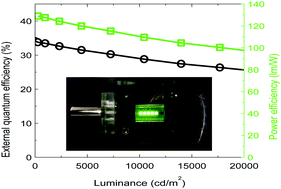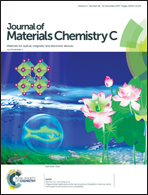Highly efficient exciplex organic light-emitting devices employing a sputtered indium-tin oxide electrode with nano-pinhole morphology†
Abstract
We propose a DC sputtering process to fabricate an indium-tin oxide (ITO) electrode with nano-pinhole morphology for an efficient exciplex organic light-emitting device (OLED). The ITO thin-film of 80 nm thickness sputtered at room temperature shows an optical transmittance of over 86.5% in the range of visible light and an electrical sheet resistance of 75 ohm sq−1. A layer of di-[4-(N,N-ditolyl-amino)-phenyl]cyclohexane (HATCN) is inserted into the device to improve the hole injection efficiency by reducing the injection barrier at the anode/di-[4-(N,N-ditolyl-amino)-phenyl]cyclohexane (TAPC) interface and simultaneously modifying the work function of sputtered ITO/HAT-CN to 5.5 eV, as characterized by photoelectron spectroscopy. The exciplex-forming phosphorescent OLEDs employing such sputtered ITO exhibit a maximum external quantum efficiency, power efficiency, and current efficiency of 34%, 132.8 lm W−1, and 127.6 cd A−1, respectively. In addition, the device shows Lambertian emission attributed to the sputtered ITO film with a special nano-pinhole morphology by enhancing the scattering effect inside the device and resulting in the improvement of the light extraction properties and device performance.



 Please wait while we load your content...
Please wait while we load your content...